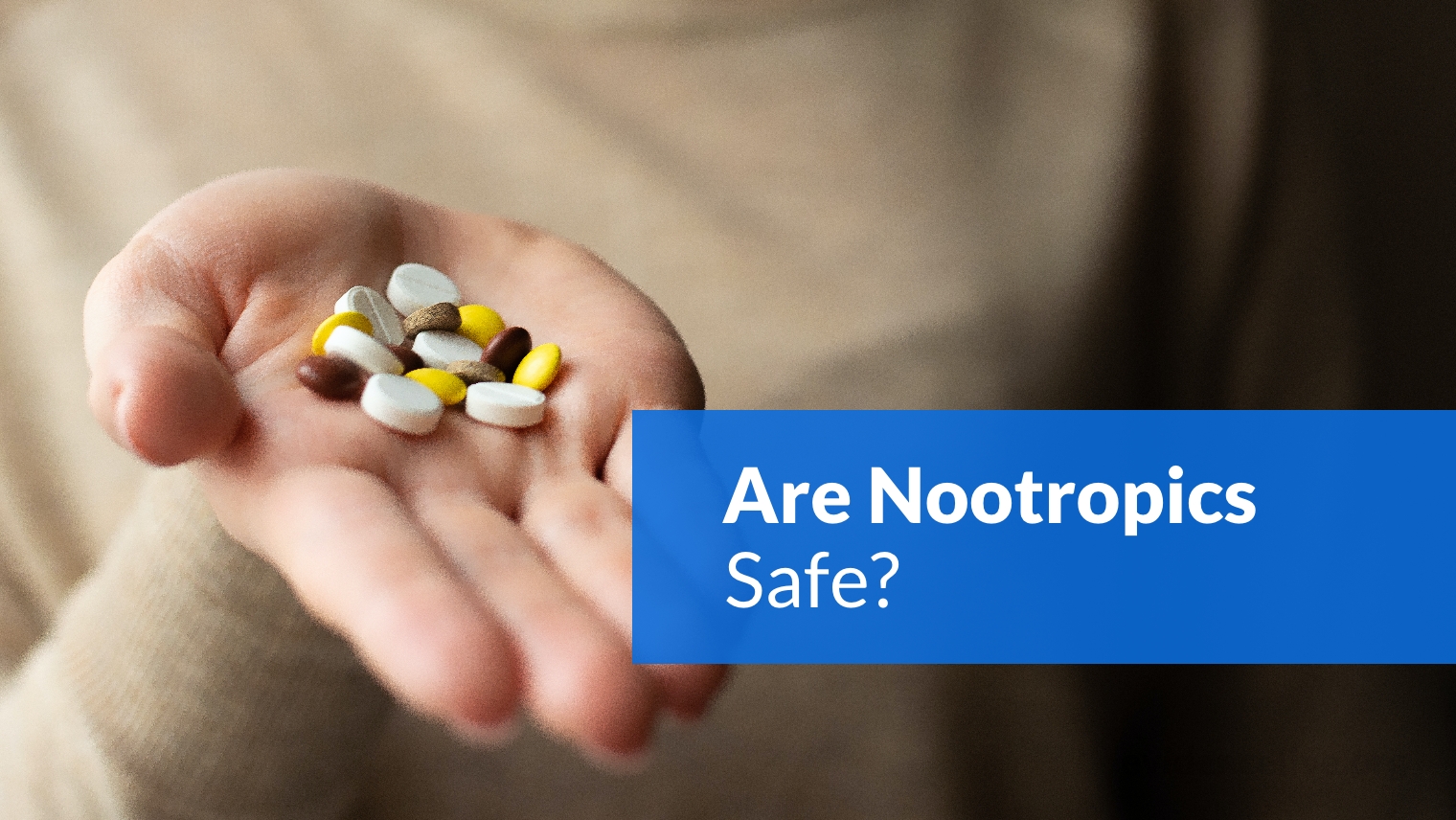Many people are searching for nootropics’ potential effects as the interest in cognitive enhancers continues to grow.
While there is limited research and clinical trials on nootropics’ long-term effects, what is available suggests that they are generally considered safe when appropriately used without overdosing.
However, some possible health risks are also associated with their use, which should be evaluated before starting, especially when taking synthetic compounds.
In this article, we’ll take a closer look at steps to remain on the safe side.
Contents
What Defines A Nootropic As Being Safe?
The nootropic safety classification depends on the specific compound quality and a person’s biochemistry.
However, unlike prescribed medication, a nootropic doesn’t need to undergo controlled studies to establish its safety before going to market. As a result, the FDA is not required to approve nootropics.
Regulation
The US has classified many nootropics as dietary supplements, and regulation is less stringent than with other drugs authorized for a specific medical condition. As a result, consumers can buy nootropics without being prescribed (1).
In addition, some prescription medications used, for example, in treating neurological conditions such as Alzheimer’s or ADHD, may also be categorized as nootropics. In this case, FDA has approved their safety and quality through a series of rigorous clinical trials.
Regulation standards differ in each country, so it is essential to familiarize yourself with the legality aspects of nootropics depending on where you live.
For example, some compounds sold in the US may only be legal and recognized as safe for research purposes, but it might require a prescription in other countries.
Nootropic Forms
Nootropic supplements typically come in branded stacks, natural nootropics, and synthetic compounds, often known as smart drugs, which also include prescription medications.
Nootropic stacks consist of combining at least two different supplements known to synergize safely and produce desired improvements in mental focus and cognitive function. An excellent example of a proven stack is combining Caffeine and L-Theanine.
Caffeine boosts concentration and brain energy. However, when taken in relatively large doses, it can affect the body by producing anxiety-like symptoms, such as jitteriness and dizziness.
Adding L-Theanine has been proven to mitigate or remove these adverse side effects, allowing you to experience safer, improved focus.
Many branded stacks undergo various studies to determine their quality and keep the nootropic use safe. Those carrying a registered trademark may also include a patented process proven to reduce potential side effects and are a good safety guide.
Natural nootropic supplements come from standardized herb extracts. Many beneficial properties of these compounds have been discovered over many years, particularly in cultures that practice alternative medicine. Therefore, many consider them to be the safest type of nootropics.
For example, Ginkgo Biloba and Bacopa Monnieri are two widely used nootropic herbs. The primary benefit of Ginkgo Biloba is known to enhance focus by increasing blood flow to the brain, making blood less sticky, and helping blood vessels to dilate.
Bacopa Monnieri, meanwhile, stimulates nerve cells to boost memory and learning capacity. In addition, anti-inflammatory and antioxidant properties found in these nootropic herbs provide a neuroprotective effect on the brain.
Another widely used natural nootropic is Rhodiola Rosea, a plant with many health benefits that stimulate neurogenesis, memory, and cognitive functions.
On the other hand, synthetic nootropic compounds, which are lab-created, usually try to imitate substances found in nature and humans. A perfect example is Citicoline, a nootropic known to be one of the best choline sources.
Generally, artificial nootropics and smart drugs are much more potent, and consumers can recognize the positive impact quicker than taking natural alternatives. However, they carry more side effects with their use.
Research-Based Safety
Scientists can understand a nootropic’s safety profile through clinical trials on humans.
For example, reviewing more than 150 human placebo-controlled studies on 77 different nootropics, results show that people taking nootropic supplements did not experience more adverse side effects than those within the placebo groups (2).
Many compounds have been tested and proven completely safe for human use, but science-based safety does not equate to proven effectiveness for the desired purpose.
Therefore, there is a lack of studies on humans for many compounds to demonstrate how certain nootropics work and if they are really effective.
Before taking any new nootropic supplement, it is crucial to research available studies for known beneficial outcomes, side effects, and ways to resolve them eventually.
Formulation and Purity
Trustworthy nootropic manufacturers will employ a range of safeguards in their processes to ensure the quality and safety of their nootropics (3).
Any nootropic used in a stack must not exceed a safe and researched clinical-range dosage, eliminating the risks of overdosing.
In addition, due to potential side effects, manufacturers will not use excessive high-risk nootropics such as racetams, eugeroics, caffeine, and other types of stimulants in their formulas.
Stacks developed with safety in mind will ensure that combined nootropics will not produce negative interactions, and instead, they will be effective brain boosters with synergic effects.
As science advances, many techniques are used in the manufacturing process of herbal-based nootropics and smart drugs to ensure consistency between batches and efficiently amplify cognitive performance while remaining pure.
However, nootropic compounds are only as good as their constituent parts and the manufacturing environment.
When manufacturers use unsafe practices and poor-quality ingredients, contaminants can get into the formulas jeopardizing safety and overall effectiveness.
Are Nootropics Safe For Long-Term Use?
Little scientific research and studies indicate that nootropics’ long-term use is unsafe (4). However, strictly monitoring your dosage and the impact of taking the nootropic is significant in determining whether it is safe for you.
Experts often advocate nootropics cycling to mitigate longer-term health risks and promote safety effectively.
Cycling is the process of taking a nootropic supplement for a certain amount of time, then having a period off, allowing the body and brain to have a break before resuming the use. The gap reduces the body’s tolerance to nootropics and improves safety.
When the body builds tolerance to a substance, the temptation might be to increase the dosage to ensure the positive impact of the nootropic.
Unfortunately, increasing nootropic dosage can lead to a risk of addiction for many users, especially with nootropic supplements that contain stimulants.
For example, Adderall, a prescription drug used in treating ADHD, can be addictive. The same risks come when taking potent nootropics like Modafinil, Aniracetam, Noopept or using them as a part of nootropic stacks.
As with any substance, dependence substantially increases the risk of side effects and long-term damage. As a result of many studies, individuals can put themselves in dangerous situations.
How To Avoid Side Effects
Before taking any kind of new brain supplements, it’s impossible to determine whether you will experience side effects.
Each nootropic impacts people differently, but there are many reports of significant dangers for patients with diagnosed mental health illnesses.
However, you can take steps to limit the severity of any side effects or, in some cases, altogether avoid them and be safe.
Research The Potential Side Effects
Spending time researching the nootropic accurately you’re thinking of taking is an excellent way of understanding potential side effects and safety.
Plenty of examination is available online, such as the results of clinical studies undertaken to monitor the amount and severity of experienced impacts.
In studies where participants have experienced few or no side effects, you can have greater confidence that the nootropic can be safe to take.
Talk To Your Doctor
Consulting your doctor before taking any new nootropics is one of the safest ways to start. Many nootropics can produce adverse effects on your well-being when combined with existing medication.
Also, if you suffer from an underlying physical or mental health condition, it can even worsen it. Therefore, your doctor can help you avoid these potential risks.
Even if you don’t take any prescribed medication, it’s still reasonable to speak to your doctor. Think about what improvements you want to gain from using nootropics and review your research with a professional to obtain a practical statement.
In addition, having regular check-ins with a medical professional to monitor the nootropic’s impact on you, both in terms of side effects and recognizing any cognitive improvements, will support you in determining the safety and whether it will effectively produce the desired outcomes.
Start With Small Doses
Beginning with a minimal effective dose is always recommended. Also, pay attention to the nootropic manufacturer’s label and suggested dosage beforehand.
Then monitor your cognitive performance throughout the use and be aware of any side effects. Depending on these, you can review your dosage.
When no noticeable improvement in mental performance occurs without experiencing any adverse effects, you may increase your nootropic dosage.
A slightly higher dose may help you achieve your desired goal. However, always consult a medical professional before, and you should not exceed the manufacturer’s stated safe clinical limits of any nootropic.
Avoid Random DIY Stacking
Pre-formulated nootropic stacks manufactured by reputable companies carry the weight of science behind them. They ensure that the nootropics are compatible and will limit adverse effects when taken as a combination.
While it is possible to develop custom stacks at home, it is essential to have the proper knowledge, ensuring the nootropic stack you’re making is safe.
Experimentation with more than one nootropic without a complete understanding of the effect can be potentially hazardous.
The more nootropics used in a single stack, the greater the chance of suffering severe side effects, causing long-term damage and threatening safety.
Conclusion
So, are nootropics safe? By having a strong awareness of the potential risks, benefits, and side effects, you can achieve the brain-boosting improvements provided by nootropics and remain safe at the same time.
It is essential to research what ingredients a nootropic supplement contains and stick to reputable nootropic manufacturers having certifications demonstrating their quality.
Seek advice from a medical professional, understand the benefits of cycling, and remain within nootropics’ safe dosage limits.
As a result, following these steps will help you stay safe while achieving your desired effect of improved brain health with any potential compound.

